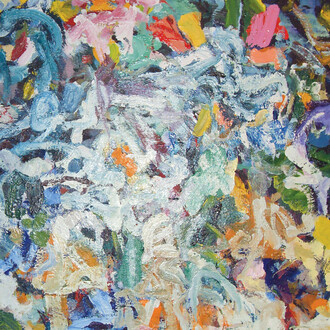The Anita Shapolsky Gallery is pleased to present “Abstract Approaches”, a comprehensive collection of many works from the The New York School of the 1950s and 1960s, as well as works as early as 1935 and as recent as 2009. Abstract art means many things. It is not as simple as a room full of gestural paintings, almost indistinguishable from one another. It varies beyond the use of linear shapes and pure geometry. Abstract artists are more complex than one style, or one viable term. This group represents the mecca of this influential art scene, whose tradition has been upheld and continues to be relevant over several decades.
The works exhibited encompass a wide range of approaches that emblematize the Abstract movement. Varying degrees of linearity are shown, as seen in Jeanne Miles’ “The Sound of Children’s Laughter” (1954). Miles work explores the divine and spiritual truths. She encourages the viewer to contemplate universal mysteries. Painterly, loose works with a representational basis are also prominently displayed as seen in Irving Petlin’s “The High Plants” (1969) and Buffie Johnson’s “Cyclical Time” (1962). Irivng Petlin is especially known for his mastery of the pastel medium and often drawing inspiration from poetry. Buffie Johnson’s work is of an existential nature. Johnson’s cosmic like paintings convey her belief in the cylindrical behavior of life with its eternal returns. The two paintings by Stanley Hayter “Pavane” (1935), a wooden collage, “Untitled”(1945), an oil painting, are the earliest works in the exhibition. Hayter was associated with the Surrealist movement as well as Abstract Expressionism. He is renowned as one of the most significant printmakers of the twentieth century. The studio he founded in Paris, Atelier 17, is legendary. The inclusion of Jeanne Reynal’s sculpture “Sphere” (1950s) nods to the diversity of mediums employed by this art movement. Reynal adopted the ancient technique of Mosaic in her pieces, and through doing so gave a sense of movement and life to flat surfaces. She used found rocks, stones, shells, marble and other semi-precious stones. She was assisted by her husband (also included in this exhibition) Thomas Sills, who would help her break up stones for her sculptures. Upon meeting Sills, an African American, Reynal left her wealthy husband and the two joined forces in both romance and art making. Thomas Sills’ paintings feature luminous organic forms and innovative compositions in lush fields of color. Carl Hecker, a sculptor, is the youngest artist included in the exhibition. Hecker’s piece “Roadflower with Puddles” (2009) uses synthetic materials and is very playful. Carl fits well in this mix because he was associated with the Martha Jackson Collection with her son David Anderson.
Artists whose works are being shown in this exhibition are pioneers and masters of the Abstract movement. The six women in the exhibition hold their own amongst the men. Betty Parsons, for example, is considered the godmother of Abstract Expressionism and was not only one of the first advocates of many influential artists, but an artist in her own right. Parsons recorded her experiences with nature using radiant luminescence and eventually turned to sculpture using found wood. She made a brave choice in showing other female artists, which at times resulted in males protesting and walking out of her exhibitions. Amaranth Ehrenhalt, another female artist featured in this exhibition, is an incredibly prolific and multidisciplinary artist. Ehrenhalt’s work has been internationally exhibited since the 1950s. Still alive and exhibiting work globally, Ehrenhalt works in painting, sculpture, tapestry, drawings, prints, mosaics, poetry and prose. Ehrenhalt’s work is frenetic, and features a fearless use of color. The dynamic energy of her work transcends to provoke an emotional response from viewers of all backgrounds. The inclusion of her tapestry piece “Aubrietta” (2008) once again enhances the viewer’s sense of the many diverse approaches to abstract art.
An overarching theme of explorations in nature, light, sensual forms, and cylindrical as well as square shapes is evident in the curation of this exhibition. The many approaches exhibited here shed light on the profound creativity of the abstract artists. What is most exceptional is the ability of these artists to express ideas while treating their subject matter with a tenderness and sensitivity. In today’s art world of constantly changing trends, few movements have stood the test of time, and certainly none can compare.



















